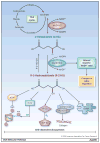Molecular Pathways: Isocitrate Dehydrogenase Mutations in Cancer
- PMID: 26819452
- PMCID: PMC4834266
- DOI: 10.1158/1078-0432.CCR-13-1333
Molecular Pathways: Isocitrate Dehydrogenase Mutations in Cancer
Abstract
IDH1 and IDH2 are homodimeric enzymes that catalyze the conversion of isocitrate to α-ketoglutarate (α-KG) and concomitantly produce reduced NADPH from NADP(+) Mutations in the genes encoding IDH1 and IDH2 have recently been found in a variety of human cancers, most commonly glioma, acute myeloid leukemia (AML), chondrosarcoma, and intrahepatic cholangiocarcinoma. The mutant protein loses its normal enzymatic activity and gains a new ability to produce the "oncometabolite" R(-)-2-hydroxyglutarate (R-2-HG). R-2-HG competitively inhibits α-KG-dependent enzymes which play crucial roles in gene regulation and tissue homeostasis. Expression of mutant IDH impairs cellular differentiation in various cell lineages and promotes tumor development in cooperation with other cancer genes. First-generation inhibitors of mutant IDH have entered clinical trials, and have shown encouraging results in patients with IDH-mutant AML. This article summarizes recent progress in our understanding of the role of mutant IDH in tumorigenesis.Clin Cancer Res; 22(8); 1837-42. ©2016 AACR.
©2016 American Association for Cancer Research.
Conflict of interest statement
K. Yen has ownership interest (including patents) in Agios Pharmaceuticals. No potential conflicts of interest were disclosed by the other authors.
Figures


Similar articles
-
Targeting isocitrate dehydrogenase (IDH) in cancer.Discov Med. 2016 May;21(117):373-80. Discov Med. 2016. PMID: 27355333 Review.
-
Molecular Targeting of the Isocitrate Dehydrogenase Pathway and the Implications for Cancer Therapy.Int J Mol Sci. 2024 Jul 4;25(13):7337. doi: 10.3390/ijms25137337. Int J Mol Sci. 2024. PMID: 39000443 Free PMC article. Review.
-
Development of Novel Therapeutics Targeting Isocitrate Dehydrogenase Mutations in Cancer.Curr Top Med Chem. 2018;18(6):505-524. doi: 10.2174/1568026618666180518091144. Curr Top Med Chem. 2018. PMID: 29773061 Review.
-
IDH mutations in cancer and progress toward development of targeted therapeutics.Ann Oncol. 2016 Apr;27(4):599-608. doi: 10.1093/annonc/mdw013. Ann Oncol. 2016. PMID: 27005468 Review.
-
Biological Role and Therapeutic Potential of IDH Mutations in Cancer.Cancer Cell. 2018 Aug 13;34(2):186-195. doi: 10.1016/j.ccell.2018.04.011. Epub 2018 May 24. Cancer Cell. 2018. PMID: 29805076 Free PMC article. Review.
Cited by
-
Therapeutic Potential and Activity Modulation of the Protein Lysine Deacylase Sirtuin 5.J Med Chem. 2022 Jul 28;65(14):9580-9606. doi: 10.1021/acs.jmedchem.2c00687. Epub 2022 Jul 8. J Med Chem. 2022. PMID: 35802779 Free PMC article. Review.
-
New Approaches with Precision Medicine in Adult Brain Tumors.Cancers (Basel). 2022 Jan 29;14(3):712. doi: 10.3390/cancers14030712. Cancers (Basel). 2022. PMID: 35158978 Free PMC article. Review.
-
2-Hydroxyglutarate produced by neomorphic IDH mutations suppresses homologous recombination and induces PARP inhibitor sensitivity.Sci Transl Med. 2017 Feb 1;9(375):eaal2463. doi: 10.1126/scitranslmed.aal2463. Sci Transl Med. 2017. PMID: 28148839 Free PMC article.
-
Prognostic importance of IDH mutations in chondrosarcoma: An individual patient data meta-analysis.Cancer Med. 2021 Jul;10(13):4415-4423. doi: 10.1002/cam4.4019. Epub 2021 Jun 3. Cancer Med. 2021. PMID: 34085407 Free PMC article.
-
Targeting IDH1 and IDH2 Mutations in Acute Myeloid Leukemia: Emerging Options and Pending Questions.Hemasphere. 2021 Jun 1;5(6):e583. doi: 10.1097/HS9.0000000000000583. eCollection 2021 Jun. Hemasphere. 2021. PMID: 34095766 Free PMC article. No abstract available.
References
-
- Sjoblom T, Jones S, Wood LD, Parsons DW, Lin J, Barber TD, et al. The consensus coding sequences of human breast and colorectal cancers. Science. 2006;314:268–74. - PubMed
Publication types
MeSH terms
Substances
Grants and funding
LinkOut - more resources
Full Text Sources
Other Literature Sources
Miscellaneous

